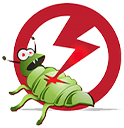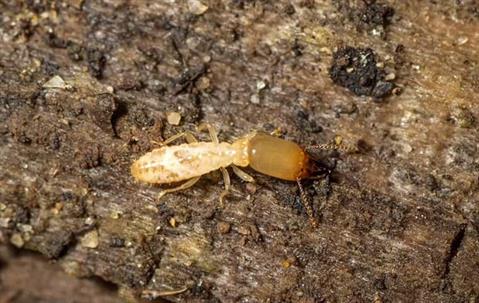Life in Bellevue can get busy. The last thing on your mind is most certainly termites. But now is the time to think about those sneaky insects. If you don't, it could come back to bite you—well, bite the wood in your home anyway. If you'd like to keep termites out of your house, we have some tips to help. We'll examine how tricky it is to detect termites and what you must think about as you search for them. We'll advise you on how termites operate and how to counteract their natural behavior patterns. Most of all, we'll let you know how to get control of termites in your home.
If you've been looking for a simple guide to help you eliminate termites, you've found it. In addition to explaining "how" termite control works, we also offer termite control services. If you live in the Bellevue area, contact yourQuality Pest Control service team to schedule a visit. Our QualityPro and GreenPro-certified team looks forward to helping you.
You're Not Likely To See A Termite: How To Identify Signs Of Activity
If your home doesn't have professional termite protection, it is critical to know how to detect these wood-devouring pests. While these tips and steps won't certify that termites won't damage your property, it is far better to take action than to do nothing at all.
The termites in Bellevue are subterranean. These termites don't damage hardwood, such as your doors and frames. Instead, they attack the substructures of your home. They also don't push their droppings out of their tunnels; they use their waste material to coat tunnel walls. Therefore, you won't find piles of frass in your home to help you detect them. Subterranean termites are incredibly sneaky, which is why they're the most destructive type in the United States. Next, we will examine the roles of a couple of different termite members within a colony and warning signs there's a colony nearby.
Workers:
This member class is the most numerous in a termite colony. These termites really don't like the light. In fact, worker termites avoid coming out of hiding even when the moon is in the sky. On top of this, they're sensitive to dry environments. Worker termites dry out easily. So, even on a pitch-dark night, they may still remain hidden if they can't find humid or damp conditions above ground. What does all of this mean? It means termites and the warning signs of termite activity are usually hard to detect.
Swarmers:
You might also catch a glimpse of termite swarmers. These members gravitate to light rather than avoid it. However, this doesn't mean they're easy to see. Swarmers avoid detection for other reasons. They only swarm in spring, and swarms last less than an hour. They then disappear into the ground to begin a new colony. Thus, you have a small window of opportunity to see them.
Warning Signs:
What kind of signs do subterranean termites provide? Because these termites are strongly associated with the ground, the warning signs they provide are typically near the earth or in dark, humid spaces just above the soil. Here are the signs you're looking for:
- Worker termites hide under wood or other objects on the ground. They are about 1/8 of an inch long, pale, and have six legs.
- Soldier termites travel with the workers and protect them. You may also find them under wood and objects on the ground. They are large, with orange heads and black pincers.
- Look for termite swarmers in the spring. A swarmer is about 3/8 inches from the tip of its head to the tips of its wings. Its body is black, and it has long, white wings.
- Look for shed wings. After mating, termite swarmers shed their wings. These wings are all the same size and have a stretched teardrop shape.
- Worker termites construct above-ground tunnels called shelter or mud tubes. These structures may appear on your foundation or other hard surfaces just above the ground.
- Look for damage to wood, particularly near damp ground. Termite damage often looks like trenches on top of each other. What you're seeing are exposed termite tunnels. If you touch the tunnels and they are smooth, they aren't termite tunnels. They are more likely carpenter ant tunnels. Termite tunnels are lined with soil and fecal matter, making them rough to the touch.
When you detect termite activity, what comes next? Do you immediately contact a licensed professional? We recommend that you do. A termite problem doesn't go away on its own. Termites establish nests, grow populations, send out swarmers, and establish more nests. Let's look at how this works.
From Bad To Worse: How Termite Damage Can Escalate Quickly
Termite swarmers don't travel far from the nest that produces them. If a few swarmers mate and select your property, they'll start to grow their nests. After years of secret activity, the nests will mature and produce swarmers. These will take to the air, mate, and attempt to build new colonies. Only a few swarmers will succeed, but the ones that do can build colonies on your property or close to it.
How fast termites grow a population and how many individuals they have in their nests depends on food availability. Here are a few conditions that can escalate termite damage:
- A pile of dead branches sitting on the ground is an ideal meal for termites. They'll increase their numbers when they find a food source like this. As they feed on those branches, they may also feed on your house.
- When termites come to your home, the last thing you want them to find is wood touching the ground. If they can enter the wood on your house without creating shelter tubes, they can work quickly without building any mud tubes for you to find.
- When termites find pressure-treated wood, they won't generally feed on it. But any wood source, even pressure-treated wood, can become a meal after being compromised by water damage. Therefore, a gutter issue can lead to a termite issue.
- If you have dying trees, logs, or stumps on your property, they will attract termites and, in turn, lead to an increase in the population of the colony. A termite-infested tree, log, or stump near your home will attract termite workers and inspire a new satellite colony.
These are examples of how the conditions on your property can increase the chance of termite problems. We'll discuss how you can alter these and other conditions to avoid termite damage in a moment. First, let's talk about termite control.
Don't Wait To Act: Contact Us At The First Sign Of Termites
Don't wait to contact Quality Pest Control when you see the early warning signs of termites. We get on top of termite problems quickly with the award-winning Sentricon® System. No other termite control product works like Sentricon®. We insert bait stations into the ground and provide a food source termites can't resist. When the workers take the bait, two things happen. First, your service specialist can easily see termites have taken the bait. They may even find workers or soldiers in one of your bait stations. If they do, you'll know that your termite protection is working. The second thing that happens is colony elimination. The workers take the bait into their colony and share it through a process called trophallaxis, effectively eliminating the colony.
Does Sentricon® work for termite removal? Yes. If termites are feeding on your home, they don't stay there; they bring the food collected back to the colony. As they travel back and forth, the workers will continue to search for new food sources and find the Sentricon® bait. When they do, it is all over for the colony.
Prevention Is Key: How To Remove Factors That Attract Termites
If you don't have an infestation yet and want to avoid a termite problem, the Sentricon® System will tackle this, too. But if you're not ready to invest in termite control for your home, there are a few ways you can reduce the chance of termites damaging your property. These tips link to the facts we shared earlier:
- Store the dead branches you pick up from your yard. Avoid leaving them on the ground.
- Put firewood on an elevated platform.
- Replace wooden fences and other wood structures with materials termites don't eat.
- Address all wood-to-soil contact around your home and in your yard.
- Address gutter issues and other moisture problems.
- Routinely inspect your house for mud tubes, damage, or the appearance of termites in hidden places.
When you find evidence of termite damage or activity, contact Quality Pest Control for industry-leading termite control in Bellevue. We'll inspect your property, advise you on specific issues, and offer termite control options to correct the problem. Our QualityPro service team strives for excellence, and we look forward to providing you with termite control you can trust. Connect with us today to learn more.


